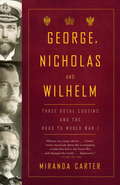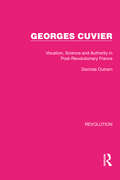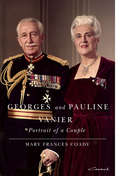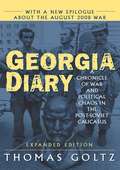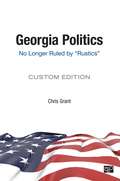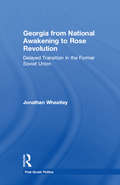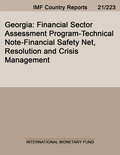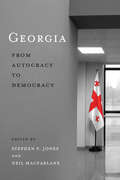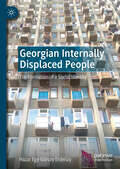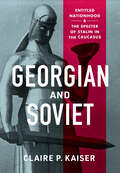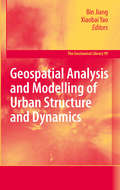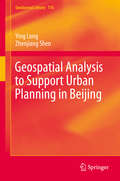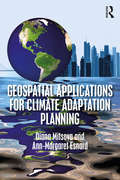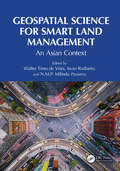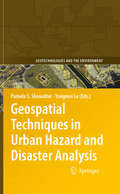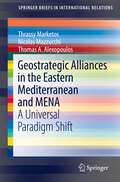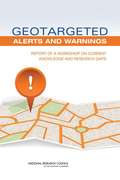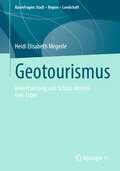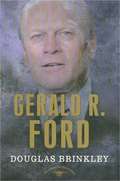- Table View
- List View
George, Nicholas and Wilhelm: Three Royal Cousins and the Road to World War I
by Miranda CarterIn the years before the First World War, the great European powers were ruled by three first cousins: King George V of Britain, Kaiser Wilhelm II of Germany and Tsar Nicholas II of Russia. Together, they presided over the last years of dynastic Europe and the outbreak of the most destructive war the world had ever seen, a war that set twentieth-century Europe on course to be the most violent continent in the history of the world. Miranda Carter uses the cousins’ correspondence and a host of historical sources to tell the tragicomic story of a tiny, glittering, solipsistic world that was often preposterously out of kilter with its times, struggling to stay in command of politics and world events as history overtook it. George, Nicholas and Wilhelmis a brilliant and sometimes darkly hilarious portrait of these men—damaged, egotistical Wilhelm; quiet, stubborn Nicholas; and anxious, dutiful George—and their lives, foibles and obsessions, from tantrums to uniforms to stamp collecting. It is also alive with fresh, subtle portraits of other familiar figures: Queen Victoria—grandmother to two of them, grandmother-in-law to the third—whose conservatism and bullying obsession with family left a dangerous legacy; and Edward VII, the playboy “arch-vulgarian” who turned out to have a remarkable gift for international relations and the theatrics of mass politics. At the same time, Carter weaves through their stories a riveting account of the events that led to World War I, showing how the personal and the political interacted, sometimes to devastating effect. For all three men the war would be a disaster that destroyed forever the illusion of their close family relationships, with any sense of peace and harmony shattered in a final coda of murder, betrayal and abdication.
George, Thomas, and Abe!: The Step into Reading Presidents Story Collection (Step into Reading)
by Martha Brenner Richard Walz Frank Murphy Donald CookThis collection features three of our most popular biographies: Washington, the stoic general with a soft spot for animals; Jefferson, the brilliant statesman who was a foodie at heart, and Lincoln, the absentminded lawyer whose compassionate caseload foretold his presidency. Beginning readers will learn about little-known, illuminating events in the earlier years of these extraordinary men and how, long before entering the White House, they lived lives filled with intelligence, courage, and kindness--the hallmarks of a great president.
Georges Cuvier: Vocation, Science and Authority in Post-Revolutionary France (Routledge Library Editions: Revolution #12)
by Dorinda OutramThis book, first published in 1984, examines the lifetime of Georges Cuvier, and in his constant and varying struggles to retain his position both as a politician and as a leading naturalist we find displayed almost all of the political tensions of Restoration France. Our understanding of the new French intellectual elite is enhanced if we can explain what sort of power this group wielded, and how it related to the structure of politics as a whole. Cuvier’s career epitomises this relationship to the highest degree. Examination of the building of his career under the Directory and Empire offers many new insights into the way the expanding market for science, the restructuring of society as a whole, and the moral authority of science itself could be utilised as resources in the making of a reputation. The influence of scientific competition and controversy on Cuvier’s scientific work is examined at length, and it is argued that they exerted a decisive effect on the structure of his biological and geological thinking.
Georges and Pauline Vanier
by Mary Frances CoadyGeorges and Pauline Vanier follows their lives and travels across the world - from Canadian military life to the League of Nations, from the inner circles of British government to their harrowing escape from Nazi-occupied France - detailing their disappointments and triumphs during social and political turbulence. With insight and sympathy, Mary Frances Coady tells their dramatic personal story. Revealing their remarkably vibrant personalities, she details the couple's support of the French resistance as well as Georges Vanier's pleas for the Canadian government to accept refugees fleeing Hitler's horrors and his effort to broaden immigration policy. She also recounts the importance of their religious convictions, their controversial standing among Quebecers, and their early advocacy of official bilingualism. An invigorating and well-told tale of their lasting legacies, Georges and Pauline Vanier is the definitive account of the enduring contributions the Vaniers made to the world and to their country.
Georges and Pauline Vanier: Portrait of a Couple (Footprints Series #15)
by Mary Frances CoadyGeorges and Pauline Vanier follows their lives and travels across the world - from Canadian military life to the League of Nations, from the inner circles of British government to their harrowing escape from Nazi-occupied France - detailing their disappointments and triumphs during social and political turbulence. With insight and sympathy, Mary Frances Coady tells their dramatic personal story. Revealing their remarkably vibrant personalities, she details the couple's support of the French resistance as well as Georges Vanier's pleas for the Canadian government to accept refugees fleeing Hitler's horrors and his effort to broaden immigration policy. She also recounts the importance of their religious convictions, their controversial standing among Quebecers, and their early advocacy of official bilingualism. An invigorating and well-told tale of their lasting legacies, Georges and Pauline Vanier is the definitive account of the enduring contributions the Vaniers made to the world and to their country.
Georgia Diary: A Chronicle of War and Political Chaos in the Post-Soviet Caucasus
by Thomas GoltzFirst Published in 2015. Routledge is an imprint of Taylor &; Francis, an informa company.
Georgia Politics: No Longer Ruled by "Rustics"
by Chris GrantGeorgia Politics, written by Chris Grant, provides students with an engaging exploration of the historical and behavioral evolution of Georgia politics. This brief chapter supplement assists instructors looking to fulfill the Georgia state legislative mandate for student competency on the Georgia Constitution. Students will explore racial diversity in the state, voting and political participation, challenges of creating educational policy, the three branches of government, Georgia’s 10 constitutions, and more!
Georgia Politics: No Longer Ruled by "Rustics"
by Chris GrantGeorgia Politics, written by Chris Grant, provides students with an engaging exploration of the historical and behavioral evolution of Georgia politics. This brief chapter supplement assists instructors looking to fulfill the Georgia state legislative mandate for student competency on the Georgia Constitution. Students will explore racial diversity in the state, voting and political participation, challenges of creating educational policy, the three branches of government, Georgia’s 10 constitutions, and more!
Georgia from National Awakening to Rose Revolution: Delayed Transition in the Former Soviet Union (Post-Soviet Politics)
by Jonathan WheatleyJonathan Wheatley examines the tortuous process of regime change in Georgia from the first pro-independence protests of 1988 to the aftermath of the so-called Rose Revolution in 2004. It is set within a comparative framework that includes other transition countries, particularly those in the former Soviet Union. The book provides two important theoretical innovations: the notion of a regime, which is an under-theorized concept in the field of transition literature, and O'Donnell, Schmitter and Karl's notion of a dynamic actor-driven transition. The volume turns to the structural constraints that framed the transition in Georgia and in other republics of the former Soviet Union by looking at the state and society in the USSR at the close of the Soviet period. It examines the evolution and nature of the Georgian regime, and ultimately addresses the theoretical and empirical problems posed by Georgia's so-called Rose Revolution following the falsification of parliamentary elections by the incumbent authorities.
Georgia: Estonia 1994 (Imf Economic Reviews Ser. #Country Report No. 15/8)
by International Monetary Fund. Monetary and Capital Markets DepartmentA report from the International Monetary Fund.
Georgia: From Autocracy to Democracy (Thirdworlds Ser.)
by Stephen F. Jones Neil MacFarlaneReflecting on the deep and complex changes in Georgian politics over the last quarter of a century, this book highlights the domestic and international developments that have shaped Georgia as a state and society. Georgia: From Autocracy to Democracy covers a wide array of topics, including the economy, elections, judicial and educational systems, relations with the European Union, and Georgia’s interaction with its regional neighbours, including Russia, Turkey, and Iran. In the book, Georgian policy-makers, practitioners, and scholars who have worked in the administration, in the opposition, in the Third Sector, and in academia provide first-hand perspectives on Georgia’s political and economic life. They demonstrate exceptional insight into the extraordinary transformations in Georgia over the last twenty-five years, from the authoritarianism of President Zviad Gamsakhurdia, through the experience of civil war in the 1990s, to democracy today.
Georgian Internally Displaced People: The Formation of a Social Identity
by Hazar Ege Gürsoy ErdenayThis book explores the construction of Internally Displaced Persons (IDPs) identity as a social group in Georgia, framed through Tajfel and Turner's Social Identity Theory. It examines the key factors shaping the identity of Georgian IDPs displaced by ethnic conflicts in two major migration waves (the early 1990s and 2008) from Abkhazia and South Ossetia. Divided into two parts, the study first looks at the historical context of the ethnic conflicts and the state's responses to displacement. The second part focuses on the formation of IDP identity, analyzing how external definitions by the host community have perpetuated devaluation? throughout the post-Soviet period. It also highlights the self-perceptions, characteristics and tactics that have helped transform IDP identity from a devalued label to a more positive and resilient social identity.
Georgian and Soviet: Entitled Nationhood and the Specter of Stalin in the Caucasus
by Claire P. KaiserGeorgian and Soviet investigates the constitutive capacity of Soviet nationhood and empire. The Soviet republic of Georgia, located in the mountainous Caucasus region, received the same nation-building template as other national republics of the USSR. Yet Stalin's Georgian heritage, intimate knowledge of Caucasian affairs, and personal involvement in local matters as he ascended to prominence left his homeland to confront a distinct set of challenges after his death in 1953.Utilizing Georgian archives and Georgian-language sources, Claire P. Kaiser argues that the postwar and post-Stalin era was decisive in the creation of a "Georgian" Georgia. This was due not only to the peculiar role played by the Stalin cult in the construction of modern Georgian nationhood but also to the subsequent changes that de-Stalinization wrought among Georgia's populace and in the unusual imperial relationship between Moscow and Tbilisi. Kaiser describes how the Soviet empire could be repressive yet also encourage opportunities for advancement—for individual careers as well as for certain nationalities. The creation of national hierarchies of entitlement could be as much about local and republic-level imperial imaginations as those of a Moscow center.Georgian and Soviet reveals that the entitled, republic-level national hierarchies that the Soviet Union created laid a foundation for the claims of nationalizing states that would emerge from the empire's wake in 1991. Today, Georgia still grapples with the legacies of its Soviet century, and the Stalin factor likewise lingers as new generations of Georgians reevaluate the symbiotic relationship between Soso Jughashvili and his native land.
Georgiana
by Amanda ForemanThe winner of Britain's prestigious Whitbread Prize and a bestseller there for months, this wonderfully readable biography offers a rich, rollicking picture of late-eighteenth-century British aristocracy and the intimate story of a woman who for a time was its undisputed leader.Lady Georgiana Spencer was the great-great-great-great-aunt of Diana, Princess of Wales, and was nearly as famous in her day. In 1774, at the age of seventeen, Georgiana achieved immediate celebrity by marrying one of England's richest and most influential aristocrats, the Duke of Devonshire. Launched into a world of wealth and power, she quickly became the queen of fashionable society, adored by the Prince of Wales, a dear friend of Marie-Antoinette, and leader of the most important salon of her time. Not content with the role of society hostess, she used her connections to enter politics, eventually becoming more influential than most of the men who held office. Her good works and social exploits made her loved by the multitudes, but Georgiana's public success, like Diana's, concealed a personal life that was fraught with suffering. The Duke of Devonshire was unimpressed by his wife's legendary charms, preferring instead those of her closest friend, a woman with whom Georgiana herself was rumored to be on intimate terms. For over twenty years, the three lived together in a jealous and uneasy ménage à trois, during which time both women bore the Duke's children--as well as those of other men.Foreman's descriptions of Georgiana's uncontrollable gambling, all- night drinking, drug taking, and love affairs with the leading politicians of the day give us fascinating insight into the lives of the British aristocracy in the era of the madness of King George III, the American and French revolutions, and the defeat of Napoleon. A gifted young historian whom critics are already likening to Antonia Fraser, Amanda Foreman draws on a wealth of fresh research and writes colorfully and penetratingly about the fascinating Georgiana, whose struggle against her own weaknesses, whose great beauty and flamboyance, and whose determination to play a part in the affairs of the world make her a vibrant, astonishingly contemporary figure.
Geospatial Analysis and Modelling of Urban Structure and Dynamics
by Bin Jiang Xiaobai YaoThe increasingly urbanized world has created various problems of environment, climate, consumption of resources, and public health, which are closely linked to the side-effects of urbanization such as sprawl, congestion, housing affordability and loss of open space. Fundamental to the urban problems are two separate yet related issues: urban structure and urban dynamics. The chapters collected in this book present an excellent profile of the current state of geospatial analysis and modelling, and demonstrate how these approaches can contribute to the study of various urban issues. The book addresses key themes including new ways of capturing data digitally at the individual level, the development of systems based around networks, the notion of linking hierarchy to networks to morphology as in complexity theory, and the development of new ways of integrating diverse urban processes through simulation paying careful attention to the basic econometric and statistical principles of spatial analysis. With a foreword by Michael Batty and an epilog by Michael F. Goodchild.
Geospatial Analysis to Support Urban Planning in Beijing
by Ying Long Zhenjiang ShenThis book describes a comprehensive framework of novel simulation approaches, conventional urban models, and related data mining techniques that will help develop planning support systems in Beijing as well as other mega-metropolitan areas. It investigates the relationships between human behaviors and spatial patterns in order to simulate activities in an urban space, visualize planning alternatives, and support decision making. The book first explains urban space using geometric patterns, such as points, networks, and polygons, that help identify patterns of household and individual human behavior. Next, it details how novel simulation methodologies, such as cellular automaton and multi-agent systems, and conventional urban modeling, such as spatial interaction models, can be used to identify an optimal or a simulated solution for a better urban form. The book develops a comprehensive land use and transportation integrated model used to explore the spatial patterns of mutual interaction between human mobility and urban space. This model can help forecast the distribution of different types of households, rent prices, and land prices, as well as the distribution of routes and traffic volume based on an appraisal of labor demand and supply. This book shows how geospatial analysis can be a useful tool for planners and decision makers to help in ascertaining patterns of activities and support urban planning. Offering both novel and conventional approaches to urban modeling, it will appeal to researchers, students, and policy makers looking for the optimal way to plan the d evelopment of a mega-metropolitan area.
Geospatial Applications for Climate Adaptation Planning
by Diana Mitsova Ann-Margaret EsnardClimate adaptation is a timely yet complex topic that does not fit squarely into any one disciplinary realm. Geospatial Applications for Climate Adaptation Planning presents an overview of the range of strategies, tools, and techniques that must be used to assess myriad overlapping vulnerabilities and to formulate appropriate climate-relevant solutions at multiple scales and in varying contexts. Organized into four sections, the book includes 15 chapters. Each chapter is grounded in the literature and presents case studies designed by the authors, as well as many examples from a diverse international group of scholars and entities in the public and private sectors. Areas covered include: Climate Change and Climate Adaptation Planning: Context and Concepts Geospatial Technologies: Fundamentals and Terminology GIS and Climate Vulnerability Assessments Technical Approaches to Formulating Mitigation and Adaptation Strategies Geospatial Applications for Climate Adaptation Planning is aimed at advanced students, researchers, and entities in the public and private sectors. It also provides supplementary reading for courses in planning, public administration, policy studies, and disaster management.
Geospatial Science for Smart Land Management: An Asian Context
by Walter Timo de Vries Iwan Rudiarto N.M.P. Milinda PiyasenaResponsible land distribution in Asia, with ever-increasing limitations in space, requires the use of smart technologies, sophisticated models, intelligent algorithms, and big data repositories. This book presents new land management perspectives and fit-for-purpose, flexible, dynamic, and effective solutions for land management and land administration problems. Written by global experts from different Asian countries, including China, India, Indonesia, Iran, Japan, South Korea, Thailand, Vietnam, etc., all these cases demonstrate how and why the uptake of geospatial technologies is booming and how to handle land scarcity and competing spatial interests in both urban and rural areas in Asia. FEATURES Summarizes trends of geospatial technologies in Asia Describes and applies leading-edge geospatial models Explains fit-for-purpose digital land administration Provides case studies and examples that include the use of smart land management tools Helps readers advance their understanding of geospatial and land management science Truly an interdisciplinary book, this text is a practical guide for an array of readers, such as practitioners in public and private companies involved in both geospatial and land management applications, as well as graduate students, researchers, academics, and professionals working in land administration, land management, spatial planning, real estate studies, geosciences, geoinformatics, and geodesy.
Geospatial Techniques in Urban Hazard and Disaster Analysis
by Pamela S. Showalter Yongmei LuThis book examines how Geographic Information Technologies (GIT) are being implemented to improve our understanding of a variety of hazard and disaster situations. The volume is a compilation of recent research using Geographic Information Systems (GIS), Remote Sensing (RS) and other technologies such as Global Positioning Systems (GPS) to examine urban hazard and disaster issues. The goal is to improve and advance the use of such technologies during four classic phases of hazard and disaster research: response, recovery, preparation and mitigation. The focus is on urban areas, broadly defined in order to encompass rapidly growing and densely populated areas. The material presented is multidisciplinary, with contributions from scholars in Africa, Asia, Europe, Latin America and North America, and is presented in five key sections: sea level rise and flood analysis earthquakes and tsunamis and international applications hurricane response/recovery metropolitan case studies evacuation studies This volume contributes to our understanding of extreme events in urban environments with the use of GIT and expanding its role at the local, regional, state and federal levels. The book is a valuable reference for academic researchers and professionals and practitioners working in hazard management and mitigation.
Geostrategic Alliances in the Eastern Mediterranean and MENA: A Universal Paradigm Shift (SpringerBriefs in International Relations)
by Thrassy Marketos Nicolas Mazzucchi Thomas A. AlexopoulosThis book examines the geostrategic alliances in the Eastern Mediterranean and MENA regions. It analyzes how these alliances transcend stereotyped political and cultural prototypes throughout western Eurasia as the outcome of shifting regional power balances. The authors explain how this development has its foundation mostly in the United States' ‘Pivot to Asia’ policy, resulting in a lower priority ranking of the Middle East for Washington, but also in the emergence of China’s economic incursion on the wider region. The book looks into and presents different reasons for this paradigm shift: First and foremost, the historical ambitions and conflicting assertions of sovereignty in the region. Then, competition over control of hydrocarbons reserves and pipeline politics, civil wars, and political chaos in certain littoral states. US retrenchment and Russia’s naval base expansion in Syria, as well as Turkish expansion in Libya, NATO allies divisions and, not to reckon with, waves of migration and refugees. Yet some internal and external factors could lead to some changes in these trends, including the need to engage in energy transitions due to climate change consequences in the region. Therefore, this book is a must-read for scholars, students, policy-makers, and practitioners interested in a better understanding of the political development in the Eastern Mediterranean and MENA regions, as well as of International Relations in general.
Geostrategic Psychology and the Rise of Forbearance (China Perspectives)
by JIANG PengBased on the framework of geostrategic psychology, this book elucidates the intrinsic law of the rise and fall of great powers and gives insights into the quandary of China's rise and the mechanism behind the strategy.Conflating geopolitics and strategic psychology, geostrategic psychology is rooted in the historical study of strategy and premised on an assumption that human beings bear resemblance in psychology and behavior when facing the same structure of geopolitical circumstance. The book analyzes intriguing phenomena from strategic psychology, including trend anxiety and conflict willingness, the Old Man Phenomenon in international politics, the Santa Claus Effect, the Myth of the Sunk Cost Fallacy, Bidder Myth, Gambler's Game, Philip Trap, William's Dilemma, Heartland Myth, Domino's Fear, Golden Nation Myth, Alliance Commitment Dilemma and Corinthian Dilemma among others. The author combines theory, history and the practice of international politics, revealing how a nation can occupy a favorable position in the field of global strategic competition and prospects for China.The title will be a valuable reference for observers of international politics as well as researchers and students interested in international relations, international politics, geopolitics, strategic psychology and geostrategic psychology.
Geotargeted Alerts and Warnings
by National Research Council Computer Science and Telecommunications Board Division on Engineering and Physical Sciences Committee on Geotargeted Disaster Alerts and Warnings: A Workshop on Current Knowledge and Research GapsGeotargeted Alerts and Warnings: Report of a Workshop on Current Knowledge and Research Gaps is the summary of a February, 2013 workshop convened by the Computer Science and Telecommunications Board of the National Research Council to examine precise geotargeting of public alerts and warnings using social media. The workshop brought together social science researchers, technologists, emergency management professionals, and other experts to explore what is known about how the public responds to geotargeted alerts and warnings, technologies and techniques for enhancing the geotargeting of alerts and warnings, and open research questions about how to effectively use geotargeted alerts and warnings and technology gaps. This report considers the potential for more precise geographical targeting to improve the effectiveness of disaster alerts and warnings; examines the opportunities presented by current and emerging technologies to create, deliver, and display alerts and warnings with greater geographical precision; considers the circumstances where more granular targeting would be useful; and examines the potential roles of federal, state, and local agencies and private sector information and communications providers in delivering more targeted alerts.
Geotourismus: Inwertsetzung und Schutz unseres Geo-Erbes (RaumFragen: Stadt – Region – Landschaft)
by Heidi Elisabeth MegerleGeotourismus, lange als eine Form des Nischentourismus betrachtet, hat sich zu einer nachgefragten Form des Thementourismus entwickelt. Im letzten Jahrzehnt erwies sich Geotourismus sogar als das am schnellsten wachsende Tourismussegment. Geoparks sind die wesentlichen Träger des Geotourismus. Sie sind keine zusätzliche Naturschutzkategorie, sondern eine Prädikatisierung für Gebiete, die ein herausragendes Geopotential aufweisen sowie eine Strategie zur nachhaltigen Regionalentwicklung. Ihre spezifischen Geotope und Geolandschaften (Geodiversität) nutzen sie für ein geotouristisches Standortmarketing. Über Geobildung wird Interesse für geotouristische Angebote geweckt und ein Bewusstsein für den Geotopschutz aufgebaut, der nach wie vor ein Stiefkind des Naturschutzes ist. Bereits seit dem Jahr 2000 besteht das Netzwerk der European Geoparks. In Deutschland können zusätzlich Nationale GeoParks anerkannt werden. 2015 wurde mit den UNESCO Global Geoparks eine weitere Kategorie von UNESCO Stätten – neben den Welterbestätten und den Biosphärenreservaten – ins Leben gerufen. Als Modellregionen für nachhaltige Entwicklung sollen sie aufzeigen, wie Ziele der globalen Nachhaltigkeitsagenda 2030 auf kommunaler und regionaler Ebene umgesetzt werden können.
Gerald Ford and the Challenges of the 1970s
by Yanek MieczkowskiA reappraisal of the brief presidency of Gerald Ford, called to leadership in the midst of scandal, stagflation, and an energy crisis. For many Americans, Gerald Ford evokes an image of either an unelected president who abruptly pardoned his corrupt predecessor or an accident-prone klutz spoofed on Saturday Night Live. In this book, Yanek Mieczkowski reexamines Ford&’s two and a half years in office, showing that his presidency successfully confronted the most vexing crisis of the postwar era. Viewing the 1970s primarily through the lens of economic events, Mieczkowski argues that Ford&’s understanding of the national economy was better than any modern president&’s; that he oversaw a dramatic reduction of inflation; and that he attempted to solve the energy crisis with judicious policies. Throughout his presidency, Ford labored under the legacy of Watergate. Democrats scored landslide victories in the 1974 midterm elections, and within an anemic Republican Party, the right wing challenged Ford&’s leadership, even as pundits predicted the GOP&’s death. Yet Ford reinvigorated the party and fashioned a 1976 campaign strategy against Jimmy Carter that brought him from thirty points behind to a dead heat on election day. Drawing on numerous personal interviews with former President Ford, cabinet officials, and members of the Ninety-fourth Congress, Mieczkowski presents the first major work on Ford in more than a decade, combining the best of biography and presidential history to paint an intriguing portrait of a president, his times, and his legacy. &“This ambitious work calls for a reexamination of the Ford presidency in light of the formidable challenges he faced upon taking office. A welcome and important addition to the literature on the Ford presidency.&” ―Library Journal
Gerald R. Ford (The American Presidents Series)
by Arthur M. Schlesinger Douglas G. BrinkleyThe 'accidental' president whose innate decency and steady hand restored the presidency after its greatest crisis. When Gerald R. Ford entered the White House in August 1974, he inherited a presidency tarnished by the Watergate scandal, the economy was in a recession, the Vietnam War was drawing to a close, and he had taken office without having been elected. Most observers gave him little chance of success, especially after he pardoned Richard Nixon just a month into his presidency, an action that outraged many Americans, but which Ford thought was necessary to move the nation forward. Many people today think of Ford as a man who stumbled a lot--clumsy on his feet and in politics--but acclaimed historian Douglas Brinkley shows him to be a man of independent thought and conscience, who never allowed party loyalty to prevail over his sense of right and wrong. As a young congressman, he stood up to the isolationists in the Republican leadership, promoting a vigorous role for America in the world. Later, as House minority leader and as president, he challenged the right wing of his party, refusing to bend to their vision of confrontation with the Communist world. And after the fall of Saigon, Ford also overruled his advisers by allowing Vietnamese refugees to enter the United States, arguing that to do so was the humane thing to do. Brinkley draws on exclusive interviews with Ford and on previously unpublished documents (including a remarkable correspondence between Ford and Nixon stretching over four decades), fashioning a masterful reassessment of Gerald R. Ford's presidency and his under-appreciated legacy to the nation.
